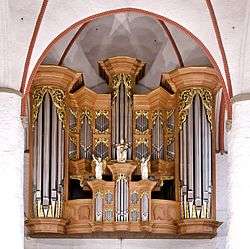Schnitger organ (Hamburg)

The Arp Schnitger organ in St. Jacobi Church, Hamburg, (St James' Church), one of the five Hauptkirchen of Hamburg, is a world-famous monument of North-German organ building, and the largest surviving baroque organ in Northern Europe.
The church was very badly damaged in the bombing of Hamburg in World War II, but the pipes of the organ had been removed and stored for safekeeping. The original case, however, remained in the church and was destroyed.
The reconstructed version of the original was re-dedicated in a church service on January 19, 1961. From 1989 to 1993, the organ was completely restored with great care and at great cost by the German Jürgen Ahrend organbuilding firm, and since its rededication at Easter 1993 it can be heard every Sunday during services and at regular recitals. The current church organist is Rudolf Kelber.
The St Jacobi organ, sited in the west gallery alongside another large but modern pipe organ, has 60 stops (registers) and around 4000 pipes, the oldest of which is from 1512. Over 80% of the pipes are from 1693 or earlier. The case of the organ shows clearly the manual and pedal divisions. The Rückpositiv division, controlled from the lowest manual, hangs off the upper gallery. The Brustwerk is immediately above the console; above that is the Hauptwerk and then the Oberwerk at the top. None of the divisions is expressive (contained within a swell box). The Pedal pipes are contained within the two Pedal towers either side. This configuration is called the Hamburger Prospekt.
An older console remains in the gallery, with wooden human heads forming the stop-knobs (to engage a particular stop, or register) portraying musicians and prominent Hamburg citizens.
Disposition
After the 1993 restoration:
|
|
| ||||||||||||||||||||||||||||||||||||||||||||||||||||||||||||||||||||||||||||||||||||||||||||||||||||||||||||||||||||||||||||||||||||||||||||||||||||||||||||||||||||||||||||||||||||||||||||||||||||
- Couplers: IV/II, II/III.
- Two tremulants.
- Trommel.
- One Hauptventiel
- Five Ventiele for the whole organ
- Cimbelstern
- Pitch: a' = 495.45 Hz at 18 degrees Celsius
- Tuning: Modified meantone
- Wind pressure: 80 mm
- Sch = Scherer (16th/17th century)
- F = Hans Christoph Fritzsche (1636)
- S = Arp Schnitger (1693)
- L = Johann Jakob Lehnert (1761)
- A = Jürgen Ahrend (1993)
External links
![]() Media related to Arp-Schnitger-Orgel in der Hauptkirche St. Jacobi in Hamburg at Wikimedia Commons
Media related to Arp-Schnitger-Orgel in der Hauptkirche St. Jacobi in Hamburg at Wikimedia Commons
- www.arpschnitger.nl Link to the specification and history of the organ
Coordinates: 53°33′01″N 10°00′01″E / 53.55028°N 10.00028°E